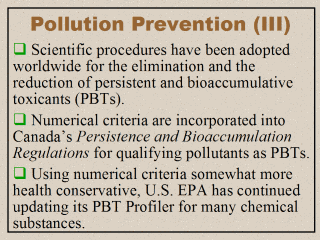| front |1 |2 |3 |4 |5 |6 |7 |8 |9 |10 |11 |12 |13 |14 |15 |16 |17 |18 |19 |20 |review |
 |
In addition to
guidance documents, regulations and scientific procedures have been adopted
for the elimination and the reduction of pollutants in the environment
worldwide that are qualified as persistent (P), bioaccumulative (B), and
toxic (T) substances, including persistent organic pollutants (POPs). For
example, not long ago an effort was made by the United Nations Environment
Programme (UNEP) to develop science-based criteria and a procedure for
identifying additional POPs as candidates for future international action (Mubarak,
1998). Another example is Canada’s Persistence and Bioaccumulation Regulations authorized under the Canadian Environmental Protection Act (CEPA, 1999). Included in these Canadian regulations are numerical criteria for classifying the persistence, bioaccumulation, and other relevant properties of PBTs. These numerical criteria, as briefly described in Slide 8, are similar to the UNEP’s.Using numerical criteria somewhat more health conservative, U.S. EPA has continued updating its PBT Profiler used to provide estimates of the persistence, the bioaccumulation, and the chronic fish toxicity potential for many chemical substances. The use of fish toxicity apparently reflects U.S. EPA’s current focus on aquatic pollution. This profiler is basically a screening tool designed to highlight toxic substances that may persist or bioaccumulate in the (aquatic) environment. It is of note that even though the PBT Profiler adopts criteria set forth recently in the Federal Register (U.S. EPA, 1999), the numerical estimates for the PBT properties are actually based on those scientific principles that have been used for years by the agency’s New Chemical Program developed for screening toxicity. |